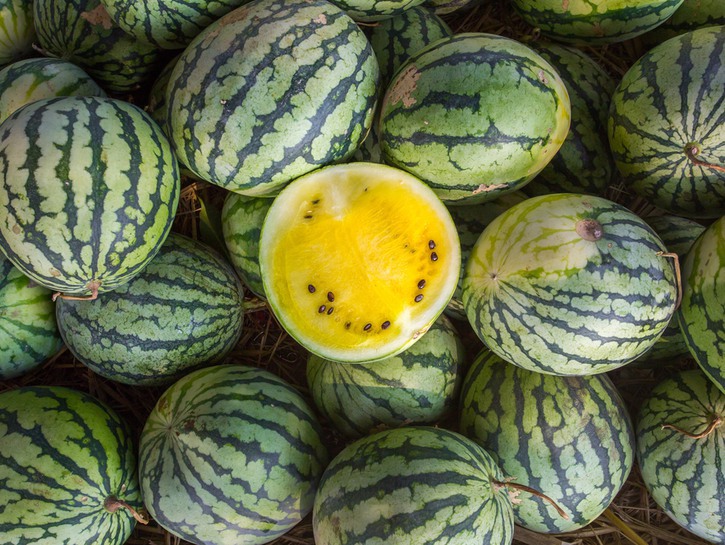What Is Yellow Watermelon?
Don’t adjust your screens; the watermelon you see above is in fact yellow. No photoshop or other photo editing software was involved and your eyes aren’t playing a trick on you.
Yellow watermelon, despite what your eyes might be telling you, is a natural variety of the sweet fruit; the only difference being that it has experienced a genetic mutation that doesn’t produce lycopene, the chemical that gives traditional watermelon its iconic red color.
Worry not, as the yellow watermelon is just as delicious and refreshing as its red counterpart, it just happens to be a little sweeter… and yellow.
What’s The Difference Between Yellow And Red Watermelon?
On the outside, red and yellow watermelon are essentially the same, but cut past the striped green outer layer, you’ll be greeted by something that it’s extremely foreign and almost alien when you see the inside of a yellow watermelon. Instead of a deep red flesh, you’re met by an almost canary yellow flesh that almost resembles that of a pineapple, at least in color.
The differences don’t stop there, though they become a little more subtle once you look beyond the color. Both varieties hold similar sweet and juicy flavor, but the yellow variety is just a little bit sweeter and tastes almost as if a dash of honey was blended into the flesh.
The other main difference between the two varieties of watermelon is the presence of of lycopene (as mentioned above) in red watermelon and the lack of the chemical in the yellow. In place of lycopene in yellow watermelon is the antioxidant beta carotene.
Beta carotene is what gives a carrot its signature orange color, but it also gives yellow watermelon’s flesh its rather odd coloring. This antioxidant is key in the body’s wellness and has even been linked to improving cognitive function, good lung health, and even cancer prevention.
Besides those few minor differences, red and yellow watermelon are essentially the same thing. At least, once you get past the appearances.

Yellow Watermelon Nutritional Value
Yellow watermelons are essentially the same as their red cousins and hold many of the same nutritional properties.
With only about 46 calories per 1 cup serving, yellow watermelon makes for one great guilt-free summer snack. But its low calorie count isn’t the only health benefit the yellow watermelon holds up its sleeve. Just like the red watermelon, the yellow variety is high in vitamins A and C, which are key in helping your body have a strong immune system.
Yellow watermelon is also a great source of potassium, with a 1 cup serving accounting for 5% of your recommended daily intake.
Fun Ways To Incorporate Yellow Watermelon Into Your Diet
Adding yellow watermelon to your diet can be a fun way to liven up food and drinks that traditionally call for traditional watermelon. Since they’re pretty much identical from a nutritional and flavor standpoint, it wouldn’t hurt to try it out.
Here are just a few of the recipes that — like the yellow watermelon — stood out the most:
- Watermelon salad with herb cucumber relish
- Red and yellow watermelon salad
- Yellow watermelon and mint pops

Where To Find One
Okay, we lied; there is one more big difference between red and yellow watermelon and that is that the latter is harder to come by unless you want to grow them yourself.
They can be purchased at regional grocery story chains such as HEB that are found throughout the state of Texas and specialty produce vendors like Melissa’s in Los Angeles, but that’s mostly because yellow watermelon tend to grow better in dryer climates like those in California and the American Southwest.
But don’t let that deter you from trying out this different take on an all-time classic like the watermelon. Check with your local grocer or farmer’s market and try one out for yourself.
